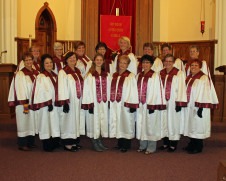Schedule
 The FELC Handbell Choir practices every Wed. evening Sept. – May from 5:30 to 6:30 in the church chapel.
The FELC Handbell Choir practices every Wed. evening Sept. – May from 5:30 to 6:30 in the church chapel.
2017-2018
We have added a Bell Choir Ensemble to our praise during worship services.
Please contact director Darla Frame for information on how to become a Bell Choir member 419-305-5066 or email at 419-234-3283
Soli Deo Gloria (To God alone the glory!)
Bell Choir showing their serious side.
Bell Choir Performances
“Bell Choir Ensemble – A Mighty Fortress – rehearsal Recorded 11/3/2024 – Listen Here!
“Bell Choir Ensemble – Joyful Joyful We Adore Thee” – Recorded 8/5/18 – Listen Here!
“Bell Choir Ensemble – All Hail the Power of Jesus’ Name” – Recorded 3/4/18 – Listen Here!
“My Hope is Built” – Recorded 2/25/18 – Listen Here!
“In the Cross/God be with You” – Recorded 2/25/18 – Listen Here!
“Just as I am” – Recorded 10/22/17 – Listen Here!
“Born, God’s Only Son” – Recorded Christmas Eve 2016 – Listen Here!
“If You’re Happy” – Recorded 5/15/16 – Listen Here!
“Come Thou Almighty King” – Recorded 1\24\16 – Listen Here!
“My Faith Looks Up to Thee” – Recorded 1\24\16 – Listen Here!
“Praise and Thanks to God” & “Count Your Blessings” – Recorded 11\8\15 – Listen Here!
History
In 1999 the music committee was approached about starting a fund to purchase handbells.
By 2000 FELC had funds donated by various members and nonmembers to complete a two octave set of handbells.
We have since added 2 more octaves giving us a complete 4 octave set.
Let the ringing begin!
Wikipedia describes handbells as follows:
The first tuned handbells were developed by brothers Robert and William Cor in Aldbourne, Wiltshire, England, between 1696 and 1724.
Originally, tuned sets of handbells, such as the ones made by the Cor brothers, were used by change ringers to rehearse outside their towers. Tower bell ringers’ enthusiasm for practicing the complicated algorithms of change ringing can easily exceed the neighbours’ patience, so in the days before modern sound control handbells offered them a way to continue ringing without the aural assault. The handbell sets used by change ringers had the same number of bells as in the towers — generally six or 12 tuned to a diatonic scale.
Handbells were first brought to the United States from England by Margaret Shurcliff in 1902. She was presented with a set of 10 handbells in London by Arthur Hughes, the general manager of the Whitechapel Bell Foundry after completing two separate two-and-a-half-hour change ringing peals in one day.
The bells used in American handbell choirs are almost always English handbells. “English handbells” is a reference to a specific type of handbells, not to the country of origin. While some American handbell choirs do use bells made in England, the majority play bells made either by Malmark Bellcraftsmen or by Schulmerich Carillons, both based in Pennsylvania.
The two major defining characteristics of English handbells are their clappers and ability to produce overtones. The clapper on an English handbell is on a hinge and moves back and forth in a single direction, unlike a school bell in which the clapper swings freely in any direction. It also has a spring that holds the clapper away from the casting after the strike to allow the bell to ring freely.
Handbells can weigh as little as 7 oz (200 g) or upwards of 18 lb (8.2 kg)

